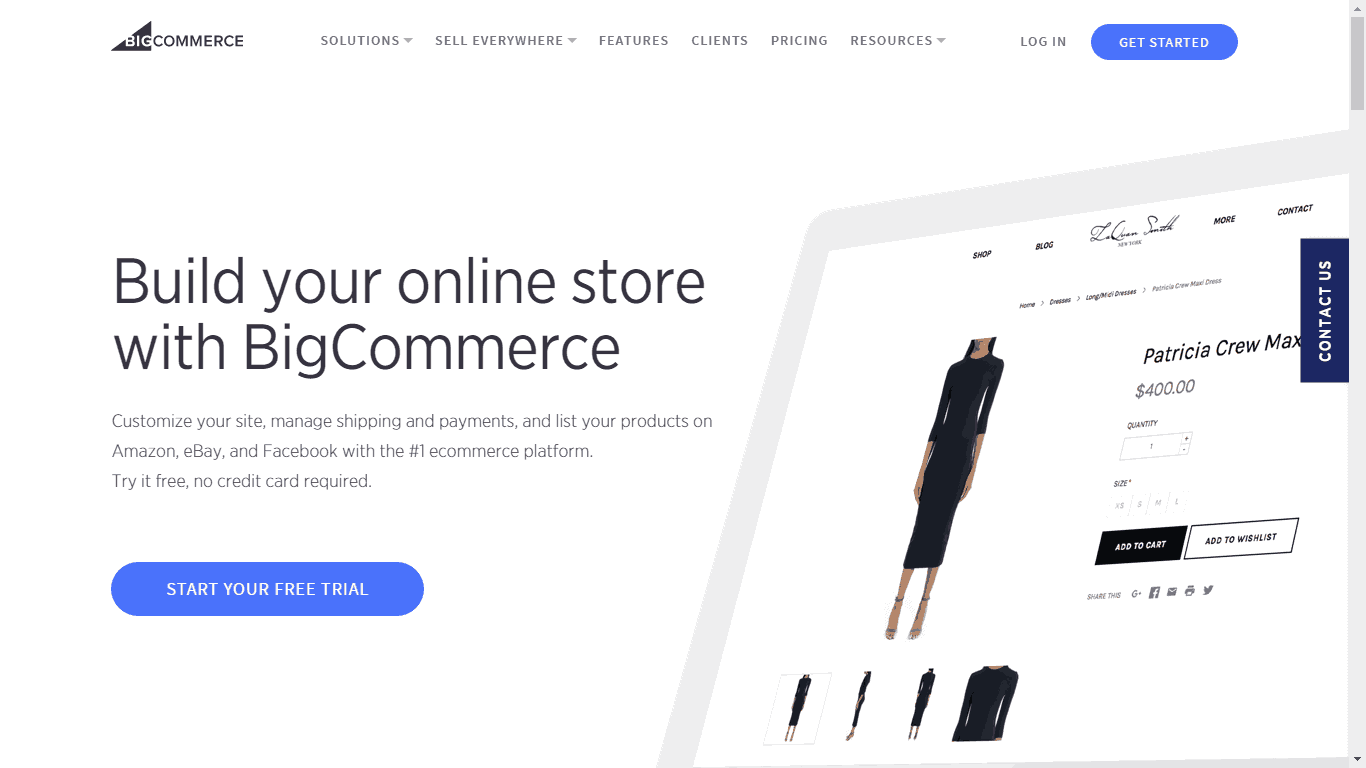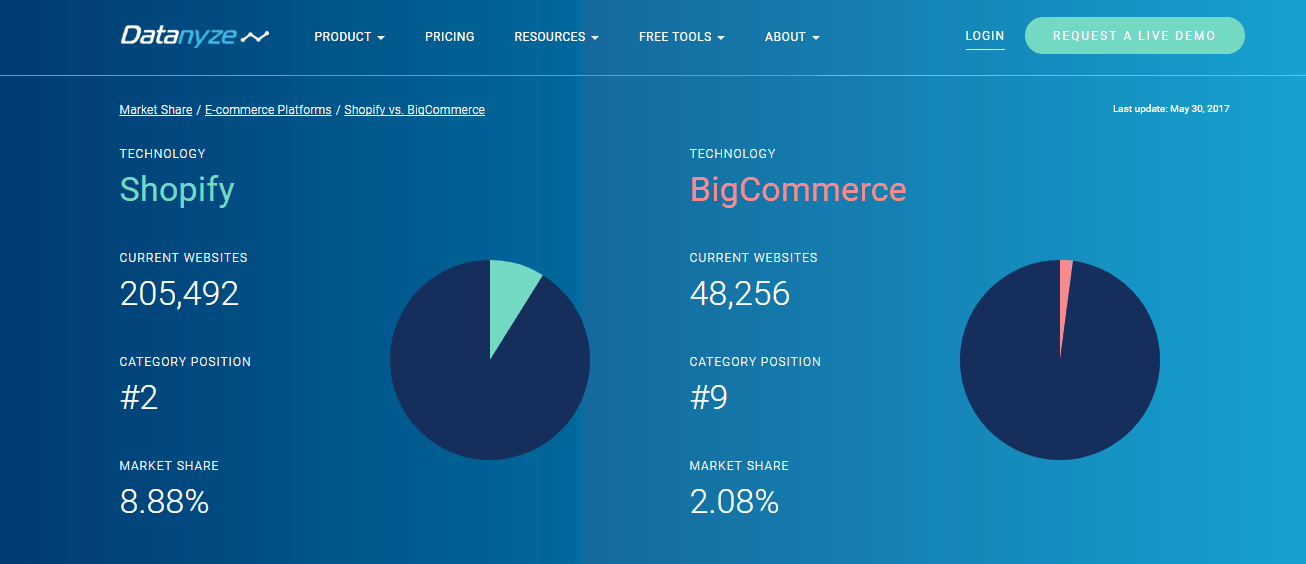

Dropshipping is a tangled beast; there is no “one size fits all” solution and anyone who says so hasn’t transacted in the thousands or millions of dollars annually. Ecommerce was my life at two companies, here’s a few thoughts on BigCommerce as a Shopify alternative.
This article is dusting off some of those old brain cells I haven’t used in a while and its for semi-advanced dropshippers. If that isn’t you, this will be a dry read.
BigCommerce, Volusion, 3dcart, Shopify, WooCommerce and even Magento are all plausible ecommerce solutions for digital nomads. IBM Websphere, not so much (it’s a behemoth for highly transactional ecommerce websites).
Shopify seems to be Numero Uno as a go-to ecommerce solution, and that’s alright –as long as you know why you’re choosing it. I wanted to bring up Big Commerce because it’s another solution I’m all too familiar with, and it might be one that more seasoned ecommerce business owners may want to consider.

My Experience with BigCommerce
To start, I’m going to speak from the hip: the BigCommerce platform was essentially a frustrating existence for me when I was a suit building ecommerce solutions for brands that transacted in the hundreds of thousands –and even millions of dollars annually.
They were heavy competition, and Shopify hadn’t quite gained the marketing momentum it has today. Plus, the cost of BigCommerce was so low in comparison to the custom solution I was selling and planning, even a solopreneur could use them.
I was always trying to pit my employer against BigCommerce, and I’ll be honest, we probably only won out at that time because of the luxury angle – higher prices and surely, surely you’re getting a more potent solution.
Simply put, I got to know BigCommerce intimately. They were “the enemy”, after all.
And then by happenstance I got to know my Toronto neighbor who worked for the company that started and later became Shopify. And I got to meet Satish Kanwar over a beer when Shopify was still a twinkle in his eye, and I know the man is all that when it comes to creating an ecommerce interface that’s easy for novices to use. A passionate genius, to say the least.
I like Shopify, I really do. And they’re Canadian (represent!), and they make complicated things simple. But they are often prescribed as a “one size fits all solution” when in reality they are more of a platform for lightweight ecommerce deployments (quite often beginners) and those that don’t transact in higher numbers, or work with specific integrations required by many fulfillment warehouses at the speeds others do (I’ll get to API speed later).
Ecommerce Migrations are Cringeworthy
There’s plenty of reasons to go with Shopify, my only issue is with those that do it blindly.
Going back to that one-size-fits-all thing; if you’re a successful dropshipper who wants to expand and grow, you will likely one day outgrow Shopify.
In which case, this article is for you. I know first-hand how heart-wrenching ecommerce migrations are when you’re moving to a new platform because you’ve outgrown its predecessor.
Reading a little about the BigCommerce vs Shopify argument might save you a lot of bullshit down the line.
All those integrations, all that SEO value you accumulate over time – a migration can be a living nightmare, even for the savviest technical person.
BigCommerce vs Shopify
In this article, I’d like to gage the interest with ecommerce among our readers. I’m just sticking my toe in the water here.
It’s a subject I could get really in-depth on and doing my own dropshipping is on my own 2018 bucket list. And after a mere two months of rapidly making Hobo generate an income I can almost fully support myself on by doing it hard and fast –and working with brands you use every day in ecommerce in my past life (if I was only allowed you tell you; you ate their food this week, you read their books, you probably made donations on their donation platform this year, and you played sports using their products) – I’ve got an angle most nomads don’t –business analysis, ecommerce solution planning, corporate marketing, search optimization, web design, and copywriting, to name a few. I know what’s under the hood of these solutions, and I know all about online merchandising.
According to research by Ipsos, BigCommerce merchants grow 28% year over year, nearly 2x the industry average.
I might bypass Shopify altogether when I personally do ecommerce. Jury is out on that one though. And this article is about why, from an editorial (read: conversational) standpoint.
If I get a lot of action on this, I’ll get technical and document my journey one day.
Product Options
One of my first most challenging clients in ecommerce was for a curtain company.
All those product options, I wanted to cry. Materials, sizes (length and width), colors and patterns, material photos, ERP integration, among other factors –agh, gag me with a spoon. It was a logistical nightmare. Runner up was when I was working on a company that sold a diverse range of industrial cabling.
Shopify is not ready for this type of client. End of story. If you’re dealing with fabrics ecommerce or even custom-tailored clothing, wallpaper, whatever – Shopify will end you.
My big question is – what do you know and want to deal with? Your ecommerce platform shouldn’t dictate the niche or product you get into. It should be the other way around. Product first, solution second.
Fabric, by example, has amazing potential. And yet by my personal experience most Shopify stores can’t touch complex products like it without opening it up and going custom. If you want to be a Purple Cow, don’t use what everyone else is using. Ugh, it hurts. Like I said, I love them, but everyone uses them, therefore they all have the same limitations with product.

When they Zig, you Zag.
Customization
Shopify is pretty. It converts. In some ways it’s the Wix of ecommerce without sucking as hard (i.e super easy to set up). I’d say it’s the “WordPress of ecommerce” but that’s reserved for WooCommerce (and would be a more respectful comparison, I know). And Shopify works for most projects. People who steer-clear of complicated ecommerce deployments use Shopify. You can add a product in seconds. Wee!
But what if your product requires a little more customization? Product should win out this argument. Put away those rose colored glasses. If you have unique needs, BigCommerce is your solution.
As a side note; if this isn’t your first rodeo, you’ll love not having to tangle with Liquid which is a programming language Shopify uses to customize its platform. It’s not a language developers line up for, thus finding a developer that knows it well means that they’re really married to Shopify, and that’s a rarity. People learn programming languages to work on projects where clients can afford them, and the average Shopify user is often somewhat frugal, which doesn’t typically attract top developer talent.
Integrations (and Speed)
As for integrations a client might have, or you might have – all those confusing custom grandfathered integrations, ERP solutions, and physical POS integrations; BigCommerce, all the way. They have all of the API endpoints you need –– and are 100x faster than Shopify’s.
Let’s put that in perspective. On BigCommerce, you could sync a 25,000 product inventory from your ERP software in 60 seconds. Shopify Plus would take 2 hours. Why? Because it has a 10 API calls/second limit. You don’t even want to know what is offered at the non-Shopify Plus level.
A critique (or WTF? moment) I have for Shopify is their Facebook-selling angle. It’s a little hipster. Beginners might think selling solely on Facebook is the best thing since sliced bread, but we already know Facebook is like an overbearing stepfather.
I always thought this angle Shopify pioneers is stupid. While it may be a successful gimmick on the short term, it won’t be a wise investment long term. Own the race course, as James Schramko always preaches. All that development on the part of Shopify could be spent, I donno, on addressing integrations and maturing its ecommerce solution.
I hate a lack of control, and BigCommerce offers more control without dabbling in questionable fads. Full stop.
Pricing
This is not a factor. Topically, the pricing is not much different between BigCommerce and Shopify. BigCommerce being a little more for their premium themes, but if you’re a successful dropshipper, the margin of price difference is so minor I just wanted to point out how irrelevant it is.
The price difference at its highest level for themes is around $40.
BigCommerce and Shopify have merchants covered mutually (they destroy Squarespace) but there’s more than that. What software is the warehouse using? Instead of recreating everything, BigCommerce is more friendly when it comes to plugging in third-party software. It’s been around longer. It’s walked a mile in more shoes.
Speaking of third-party software, while you’ll need to connect with your warehouse on either BigCommerce or Shopify, think about this:
BigCommerce natively supports 60% of Shopify’s most used apps. Those are apps you have to pay money for on Shopify – and they just come included on BigCommerce. Add that up in your head.
How much more cost does that add to Shopify for you?
In Summary
Pricing is incredibly similar, BigCommerce is more scalable. I could drop the mic there.
If you want simple point and click, get it out the door, this-is-my-first-rodeo product support, go Shopify. By all means. If you’ve been in the game awhile, take a look at BigCommerce.
It’s the same argument as Mac vs PC or Ubuntu –how much control do you need? If price is your deciding factor, I totally didn’t speak to your needs.
Few platforms put such advanced product options into a non-custom graphical interface. Meaning that normal people can still use BigCommerce with more control than Shopify.
If there’s interest in this topic, I will go into more detail, I know that I was lacking. I really, really, do. Programmers would hate this article and I’ll likely be skewered for it later. Although any developer who has an opinion on this, I urge you to leave a comment. I know warehouses and business requirements, I don’t know code as well as you do.
What are your thoughts? Let me know in the comments. More than anything, what are your experiences with the customer service of either? How complex were your challenges?
And should I give ecommerce another go, in another article – do you care what I think, or should I let this topic go?







10 comments
Hi Michael,
This is was an interesting read. You are 100% right. I use Shopify when I have to and recommend it for other novice and those looking for making a quick buck. But it is never the only option or even the “best” one. It all depends on how much customization and adaptability you need. In the case of a seriously big client with products that require a lot more than what Shopify offers, I definitely recommend other solutions. Shopify is for the small to medium guys, not the big bulls.
Thank you for this piece!
Glad you dig, Stefan –and yeah, Shopify is awesome, but not for everyone. All depends on the requirements.
Thanks for stopping by!
No love for WooCommerce?
Don’t get me wrong, I love all ecommerce tools. They all have a place.
Woo is the worst for serious ecommerce, unless you have a team. It’s good for up to $100,000 per year, and that’s low, but beyond that I only trust a managed solution.
How worse? WooCommerce is more for serious e-commerce I would argue. BigCommerce as a SaaS, you basically rent the space, you have no FTP access, no back end access, it’s a glorified Shopify with more features. You put everything in their hands and don’t own anything yourself in the long run.
We’re talking about apples and oranges here. I am talking about ecommerce deployments that generate $100k+/month –Woo IS good, but like I said, if you have it managed by a team.
For a one man show, I’d stick with a managed solution.
As a person who is interested in the whole drop-shipping thing, I’d love to see more about this. It sounds like the age-old mantra: You pay me now or you pay me later. In terms of ease of use, Shopify sounds OK, but if you need to migrate…that’s going to hurt. Just thinking about migrating something that touches ERP (even if it is downstream), makes me cringe.
Is there a product count threshold where you go Shopify vs. BigCommerce? I don’t know if there is a magic number, but at only 10 API calls/sec (SLOOOOOW), that threshold seems to be extremely low. That’s some serious eCommerce food for thought!
Great question, Alan!
I’m a little rusty. But I will give you a really fast short answer before I get into a novella: Simple dropshipping? I’d go Amazon FBA and scratch any of the solutions I mentioned in this article. Amazon will handle all of your systems, ideal for a beginner.
Long answer?
This is one of those questions where I have to be a smart ass and say “how long is a piece of string?”. Too much I just don’t know about what you’re considering. And from some of the words you used, I sense you know a thing or two about a thing or two.
My professional experience here is to ask the right questions, and then communicate answers to a developer in a way they can work with in a briefing, and then plan a solution with all parties. Only when the heads of an entrepreneur, business analyst (I am self professed, I didn’t got to school but I studied the UML independently), developer, and UX/UI designer get together would you get the Perfect Answer. And I probably left out a few team members 😉
It’s late where I am, but I’ll wing it! On a fresh install;
I’d look at your products and their attributes first. The variables can make your head spin on custom products, like the ones in the article.
If you’re just dropshipping a toaster and they’re all the same and you never want to introduce other products with other variables, like custom sizes, same product family but different weights, colors, etc. then there’s less concern (ie. a one product store). Sure there’s categories and what have you, but it can become a dog’s breakfast pretty quickly when you grow the variety of products you aim to sell –and it’s a nightmare to move around the drywall, wiring, and pipes.
It’s not impossible to grow your business on Shopify, but as you grow, your needs and wants will, too. Then it starts to feel like a Thai telephone pole. A mess. That’s why I like BigCommerce.
Variables and inventory effect product display on the site, logistics in the warehouse, whether API calls need to be live or chronological tasks (every night for instance), and shipping as well.
A quick example: If you’re doing one-off or custom products with little or no inventory, those live/fast API calls are more important. Selling 1 per hour, Shopify could be ideal. And then the Slashdot effect happens; some influencer mentions you, and blam –1 million customers start processing orders. Your store breaks and you lose serious capital. People blog about it. You’re done. There goes Inventory Management, right out the window.
On the contrary; If you have a lot of product and can sync the system nightly, it’s safer but not bulletproof. A system like Shopify works well with an inventory in place because it’s slower with those API calls. But then you need to buy an inventory. So that speaks to your parlance “pay me now or pay me later”.
I wrote more but I think this clusterf*ck is already long enough 😉 It’s completely doable, but you’ve got some risk you need to balance no matter which way you go.
And these are just a couple underlying facts why I pissed on the whole “Dropship Lifestyle” back in 2015. I’m sure they’ve refined their education to set better expectations by now (I would hope) but in the beginning they didn’t. I met some of the 21 year-old kids who got squashed. Selling ecommerce with a lifestyle attached to it without enough expectations set from the get-go to a bunch of Millennials is a cruel joke –especially when you also encourage them to travel overseas for part of the training. And therein lies a lot of the drama in Chiang Mai in recent months.
heh, I hope that helped. If this is your first rodeo, you will learn a whole lot from Amazon FBA, and it’s reputable and trusted by consumers.
Thanks for the recommendation on Amazon FBA. All this talk about retail brings back memories of dealing with retail software and retail customers. Ick! Your last para about CM made me chuckle a bit. Not that I’m laughing at someone’s misfortune, but that whole, “There’s gold in them thar hills” mentality kind of cracks me up.
Anyway, kòp kun, and travel safe.
lol agreed. Gold rush. Shovels.
I have to admit, writing this post and discussing ecommerce with you was a little fun and nostalgic. I might have a few years of corporate work left in me when I have some kids in Canada. Of course, anything I do will have to be majority remote work 🙂
Boy, do I miss those board rooms, and planning big projects.
Wagoners, ho! Happy trails, Alan.